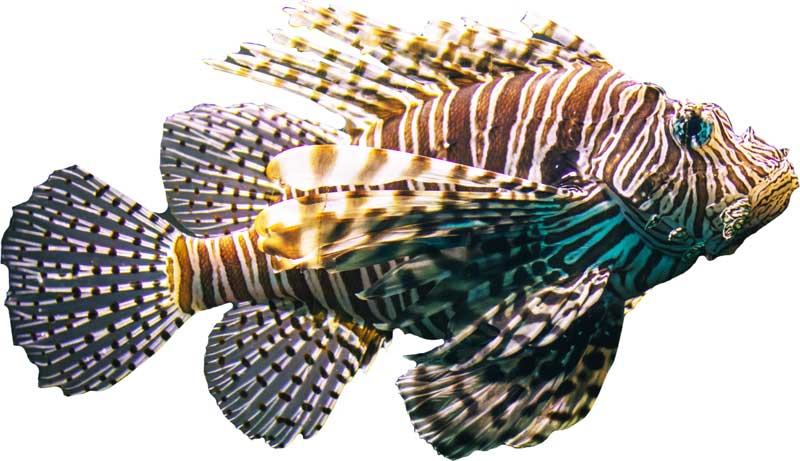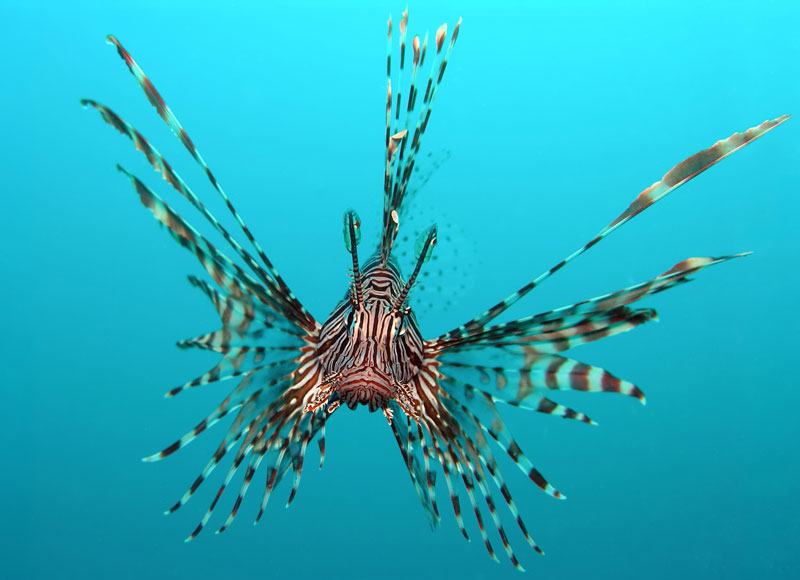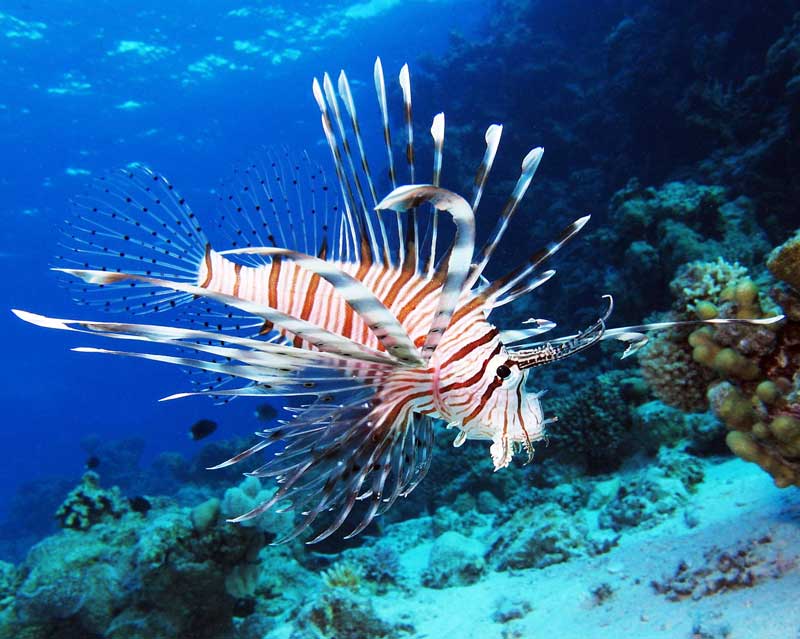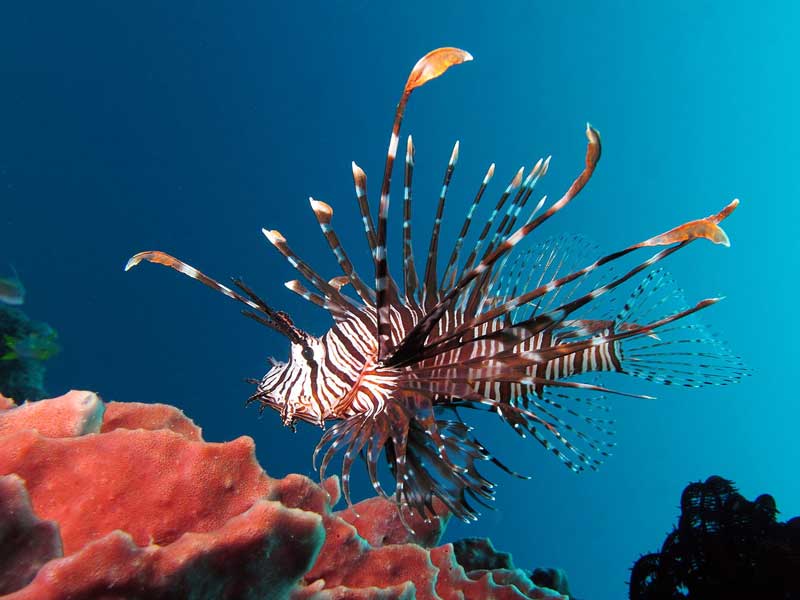 Lionfish dwell in oceans and are known for their venom. They belong to the Genus Pterois and the Indo-Pacific Ocean area is their home. It is also popularly known with various names, such as firefish, zebrafish, tasty fish, turkey fish, and butterfly-cod. They are known as invading (attacking) species.
Lionfish dwell in oceans and are known for their venom. They belong to the Genus Pterois and the Indo-Pacific Ocean area is their home. It is also popularly known with various names, such as firefish, zebrafish, tasty fish, turkey fish, and butterfly-cod. They are known as invading (attacking) species.
What Do They Look Like?
 Lionfish have many attractive colors with black, red, white, and creamy stripes. They also possess tentacles and fan-like pectoral fins. They propel gently in waters with their soft rays and slowly move their fan-like fins. Lionfish upon looking appears as soft and delicate fish. They have dorsal (over the back), pectoral (breast or chest), and under-side spines.
Lionfish have many attractive colors with black, red, white, and creamy stripes. They also possess tentacles and fan-like pectoral fins. They propel gently in waters with their soft rays and slowly move their fan-like fins. Lionfish upon looking appears as soft and delicate fish. They have dorsal (over the back), pectoral (breast or chest), and under-side spines.
Lionfish possess noticeable maroon, white, and brown stripes that run around their head and body. They have thirteen dorsal and three anal spines. They have 10 to 11 dorsal soft rays and up to seven anal soft-rays.
Lionfish babies are as small as one inch or even less. Whereas, their adults may be as long as 18 inches long. They possess scales having an oval or elliptical shape. The edges of the scales are quite smooth.
Habitat
 Mostly all types of marine habitats are suited to lionfish; especially those located in tropical regions. The typical place where they can easily be found are mangroves, corals, seagrass. They are also found in depths of water extending up to 300 feet.
Mostly all types of marine habitats are suited to lionfish; especially those located in tropical regions. The typical place where they can easily be found are mangroves, corals, seagrass. They are also found in depths of water extending up to 300 feet.
Basically, lionfish belongs to the South Pacific and the Indian oceans. However, their habitats range from Australia to Japan and South Korea. The Seaward edge of reefs, coral areas, rocky areas constitute their habitat. They prefer turbid (cloudier) waters.
Diet
Lionfish (Pterois fish) usually catch and eat small fishes, invertebrates (creatures having no vertebral spine), and mollusks (e.g. snails, slugs, mussels, octopuses, etc.).
They feed themselves heavily during early morning hours after sunrise. They can alter their center of gravity to acquire a better position for the attack on their potential prey which they swallow in a single leap. In fact, they eat a wide variety of marine creatures. They can even hunt creatures that are about half of their own length.
Reproduction – How They Are Born?
 They attain sexual maturity within a year or sometimes earlier. They lay eggs throughout the year in warm waters. The Egg-laying process can extend up to 3 or 4 days. The number of eggs laid by females may reach up to 30,000 eggs in each batch.
They attain sexual maturity within a year or sometimes earlier. They lay eggs throughout the year in warm waters. The Egg-laying process can extend up to 3 or 4 days. The number of eggs laid by females may reach up to 30,000 eggs in each batch.
A group of lionfish, generally, is comprised of one male lionfish and few female lionfish. The male lionfish follows a mating scheme. The male Lionfish presents various skills and strengths to attract a female that suits it. The male lionfish fertilizes the eggs laid by female lionfish. After having the eggs fertilized, the male and the female lionfish Lead to their own ways separately.
Only a day after being fertilized, the eggs produce larvae that strive for seeking a place suitable for their hide. Also, the larvae would prefer to find a place that makes it easy for them to cling (get a hold on). In a time-span of about 4 months, they reach maturity.
Conservation Status
They are not currently facing the danger of extinction. However, the increasing pollution of coral reefs can cause a negative impact on their primary food sources. Also, if the species of their prey goes on a decline, Lionfish itself might face danger to their survival.
Interesting Facts
- Lionfish have quite a strong venom that can make a person very sick, such as vomiting, breathing difficulty, and strong pain.
- Lionfish have a characteristic of cannibalism which means they will not hesitate to eat other lionfish if the food is very limited.
- An average-sized lionfish normally live for around 5 years and a maximum of 15 years.


